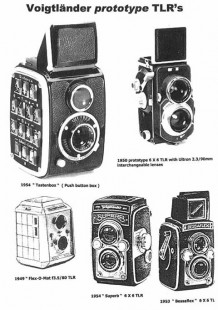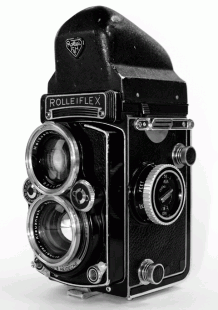The war was now over and Voigtländer were seeking new products. With the help of Carl Zeiss, who were in the Eastern part of Germany - then under the control of Russia, it was difficult to obtain permission for any new proposals.
The Rolleiflex TLR was a very popular and user friendly camera during the war. Reliable and easily mended. However, there were those who thought that they could build or design a better TLR. This included Voigtländer, whose factory was also in Braunschweig. Competition between the two firms was always at fever pitch.
There is no doubt that Voigtländer's new research team were very motivated in trying to find ways of expanding, and at the same time modernising the entire business concept that was now reaching its 50th birthday in Braunschweig.
The 6 X 6 ‘folders’ were still in production and would remain so for another 8 years or so. Dr. Faulhaber, a designer, said that a new modern TLR camera was required to compete with Rollei. The first camera he designed was named Flex-O-Mat with a f3.5/80mm Color-Skopar lens. This 6 X 6 camera had instructions on both sides of the camera. At that time, the target sales market was the USA, with valuable dollars being the favourite currency of the period, hence the instructions would have been in English. The Flex-O-Mat did not go beyond the drawing board stage but some years later, in 1954, a number of these redesigned cameras were built. The exact number is unknown.
To test the market, a production run of 100 cameras was commissioned. The choice of the camera's name caused some dispute. Some thought that the camera should be called "Good Luck" others thought that "Tastenbox" (Push Button Box) . The idea was taken from the first Kodak box brownie camera. "You push the button, we do the rest!" This slogan helped the sale of millions of cameras. Recently APS cameras were sold on the prefix that loading the camera with film was very simple.
In the 1950's cameras were in very short supply and I am surprised that the R&D department were able to find the time and resources to design such a camera. In February 1972 when Rollei bought Voigtländer, I had a good look through the factory and the design department. Alas, in the R & D department all the prototypes had gone. Herr Schluter the Betriebsleiter, (manager of the optical department) commented that Rollei had all the designs, tools and hand made prototypes of the 35mm Zeiss Ikon and Voigtländer cameras, as well as all drawings from the previous year. He did not know who had the contents of the R & D department or where they might be, except for books and various papers that soon found their way into my car.
When Rollei bought Voigtländer, they acquired all the tools, equipment, patents, work in progress and the complete design shop. The factory was not included, but the name Voigtländer and other various trade names associated with lenses and previous cameras were. Later Rollei sold on the registered trade names.
Market for Prototypes
In 2002 a "Tastenbox" prototype camera emerged for sale in a Auction Team Koln. For current listings see Brecker Auctions. The camera for Auction was numbered ‘69a’ (‘a’ for pre-production) I saw one of these cameras in 1954, the year after I was married. I visited Voigtländer's factory at Braunschweig and remembered seeing what I thought was a toy camera. The camera looked like a toy. There was no provision for a camera strap.
In Auction Team Koln there were seven very collectable Voigtländer prototypes for sale. Drawings of a "Superb", to be marketed in 1954 and another 6x6 TLR were left in the R & D department. The one I liked was the modern looking 1953 " Bessaflex " with a f3.5/80 lens, although I have been told that the lens was a f3.8/80, but I am sure that this is not correct. Both these camera’s drawings show the same side panel design shape as the "Tastenbox” camera on sale in Koln. The other camera on sale is an interchangeable lens 6 X 6 TLR to rival that of the French company Photorex of St. Etienne.
On that camera the lens panel could be replaced with either a 75mm lens or a 135mm lens. Zeiss heard about this camera when the French company gave an order for some shutters in 1949. The camera went on sale in 1950. As the French Photorex company had difficulty in meeting its financial obligations, Zeiss did not put much pressure on Voigtländer to bring an interchangeable TLR to the market. It was left to Mamiya to introduce a TLR, with a range of interchangeable lenses, onto the photographic market in 1956.
For those interested in the various TLR cameras we would recommend McKeown's camera price guide. There must be many prototype TLR's that never made it to the market place. Certainly this auction will attract much interest, and prices will certainly go through the roof. Maybe a Club member will buy one of the lots and we shall see a feature in the club magazine… For my part, my wife says "I have no spare money for anymore cameras that she will have to dust", whilst holding a shot gun behind my back!

